Trumpeter 1/32 Ju-87B-2 Stuka
|
KIT #: |
03214 |
|
PRICE: |
$87.99 SRP
|
|
DECALS: |
Three options |
|
REVIEWER: |
Tom
Cleaver |
|
NOTES: |
New tool kit |
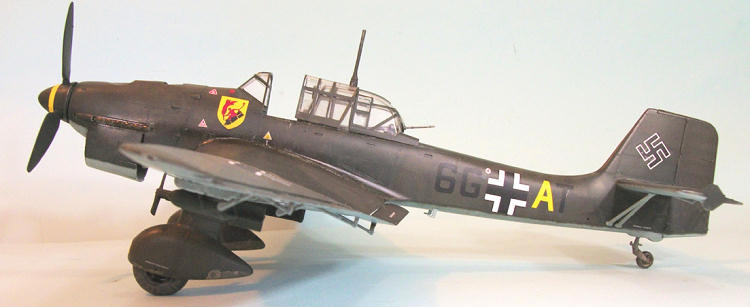
The Ju-87 Stuka (from Sturzkampfflugzeug, "dive bomber")
is one of the most iconic aircraft of the Second World War and is one of the
symbols of the blitzkrieg of 1939-40.
Opeating from advanced airfields as the battle lines
changed, the Ju-87s made pinpoint attacks against Allied military formations and
refugee columns.
Their infamous Jericho‑Trompete
("Jericho
Trumpet") wailing siren, became the propaganda symbol of German air power in the
conquest of western Europe.
The Junkers Ju 87 was designed by Hermann Pohlmann, one
of the two designers of the K.47, the first German dive boming aircraft, which
first flew in 1932.
Pohlmann believed any dive‑bomber design needed to be
simple and robust, which led to a retractable landing gear being dropped in
favor of one of the Stuka's distinctive features, its fixed, "spatted" landing
gear. The dive bomber concept was enthusiastically supported by Ernst Udet once
he took over as head of the technical design department of the RLM, despite the
opposition of Ernst Milch and Wolfram von Richtofen to the idea.
The first Ju-87 flew in 1934 with a tw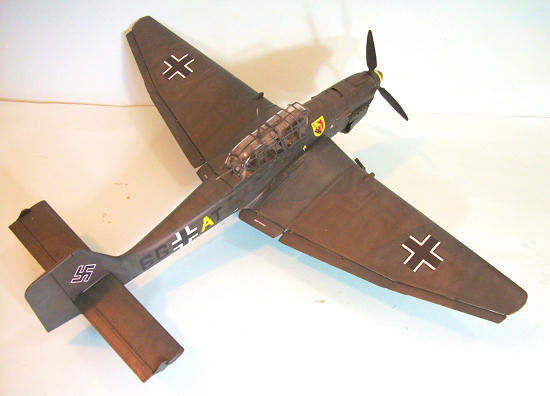 in-rudder
configuration that was not strong enough to withstand aerodynamic forces in
pulling out from a dive, and the aircaft was lost due to airframe failure.
This led to the adoption of the single-rudder design.
The Ju-87A was considered inferior to the competitive
He-118, with von Richtofen declaring it underpowered.
Following Udet's crash in the He-118, the Ju-87 was
given priority for further development.
in-rudder
configuration that was not strong enough to withstand aerodynamic forces in
pulling out from a dive, and the aircaft was lost due to airframe failure.
This led to the adoption of the single-rudder design.
The Ju-87A was considered inferior to the competitive
He-118, with von Richtofen declaring it underpowered.
Following Udet's crash in the He-118, the Ju-87 was
given priority for further development.
While the Ju-87A was restricted in the bombload it could
carry, the three airplanes sent to
Spain
demonstrated their ability to make accurate bombing attacks, which confirmed the
Luftwaffe command in giving priority to the dive bomber.
Udet went so far as to demand that all medium bombers
have dive bombing capability, which did much to ruin the development of
second-generation medium bombers such as the Do-217 series.
The Ju-878B was the first version of the Stuka to attain
mass-production, with the prototype first flying in 1937. As compared to the
Ju-87A, the B model featured a more powerful engine, with its Junkers Jumo 211D
generating 1,184 h.p., and a completely redesigned fuselage and “spats” for the
landing gear rather than the “trousers” of the A-model.
After proving is ability in
Spain,
production of the Ju-87B-1 was increased to 60 per month; at the outbreak of war
on
September 1, 1939,
the Luftwaffe had 336 Ju-87B-1s on hand.
This was the first version to be fitted with the
Jericho‑Trompete,
propeller‑ driven sirens with a diameter of 2.3 ft.,
mounted on the wing's leading edge directly forward of the landing gear, or on
the front edge of the fixed main gear fairing.
While Ernst Udet is commonly considered the inspiration
for this device, some sources say the idea came from Hitler himself. The effect
of these wailing sirens was to weaken enemy morale and enhance the intimidation
of dive‑bombing. The
sirens caused a loss of some 10‑20 mph through drag. They were replaced soon
after the 1940 Blitzkrieg when it was determined that enemy troops were used to
them, and bombs were fitted with whistles on the fin to produce the noise after
release.
697 B‑1s were
produced, 311 by Junkers, 386 by Weserflug, with
225 B‑2s - 56 by Junkers, 169 by Weserflug. The last Ju
87B came off the production lines in October 1940
The Ju-87R was a long-range version of the Ju-87B, with
the wing plumbed to allow use of two 300-litre drop tanks.
These aircraft saw considerable use in the
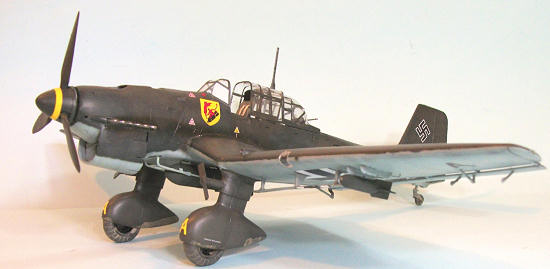 Mediterranean
in 1941, and were particularly effective against the Royal Navy.
Mediterranean
in 1941, and were particularly effective against the Royal Navy.
While the Ju-87B had a fearsome reputation as a result
of the 1940 Blizkrieg against western Europe, the aircraft's reputation went
into decline as a result of high losses during the early stages of the
Battle
of
Britain,
which saw the aircraft withdrawn from front line use over
Britain.
This was due to the Ju-87 being used in a situation
where the Luftwaffe did not have complete air superiority.
In fact, no dive bomber used in the Second World War
could survive on its own against modern fighters, which is why dedicated dive
bombers were eventually replaced by fighters modified to carry bombs as
“fighter-bombers.”
After it's “failure” in the
Battle
of
Britain,
the Ju-87B was used very successfully in the Balkans campaign, the Mediterranean
anti-shipping campaign, and the early stages of the invasion of the
Soviet Union.
Famed British test pilot Eric "Winkle" Brown, commander
of the RAE's Captured Enemy Aircraft Flight, tested the Ju 87 at RAE
Farnborough. He recalled:
“I had a high opinion of the Stuka because I had flown a
lot of dive‑bombers and it's the only one that you can dive truly vertically.
Sometimes with the dive‑bombers, pilots claim that they did a vertical dive.
What a load of rubbish. The maximum dive is usually in the order of 60 degrees.
In a dive when flying the Stuka, because it's all automatic, you are really
flying vertically. You feel that you are over the top and feel you are going
that a way! The Vengeance and Dauntless were both very good but could dive no
more than 60 or 70 degrees. The Stuka was in a class of its own.”
For a full look at “what's in the box,” check out Scott
Van Aken's
preview.
There have been two other Ju-87B kits released in 1/32
scale, one by Revell which dates to the 1970s, and one given a short release by
21st Century Toys in 2007.
This Ju-87B is the first release of an announced Ju-87
series by Trumpeter that will include the Ju-87D and Ju-87G.
Personally, given that Hasegawa “owns” the late Ju-87 in
1/32 scale, I think that Trumpeter is late to the game with anything other than
this early Stuka.
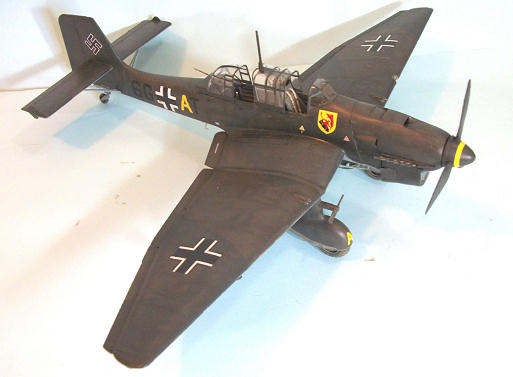 The kit benefits from the fact that Trumpeter's “mad
riveter” was on vacation the week it was designed.
Trumpeter has obviously studied the Hasegawa kits and
created a very clean design.
In fact, all these “clean” Stukas are wrong, since the
real thing had raised rivets everywhere; the only model company to ever get the
Stuka right in regards of surface detail is Airfix with their 1/24 and 1/48
Ju-87B kits.
The kit benefits from the fact that Trumpeter's “mad
riveter” was on vacation the week it was designed.
Trumpeter has obviously studied the Hasegawa kits and
created a very clean design.
In fact, all these “clean” Stukas are wrong, since the
real thing had raised rivets everywhere; the only model company to ever get the
Stuka right in regards of surface detail is Airfix with their 1/24 and 1/48
Ju-87B kits.
As with most Trumpeter kits, there is good and bad to
report.
The overall outline of the kit is accurate.
However, the spats for the landing gear are far too
shallow in their profile, as well as having an incorrect profile shape.
Also, Trumpeter has supplied ordnance and underwing
racks for its carriage that are all appropriate to the Ju-87D series, not the B
series.
The outer bomb racks for the Ju-87B are kinda/sorta supplied, though
they are not the right shape. In particular, the 1100kg bomb that is supplied
would have been impossible for the Ju-87B to carry.
Sadly, the swinging rack for the bomb is also correct
for the Ju-87D and not the B.
Modelers will either have to live with these
deficiencies or figure a way to correct them.
The decal sheet is particularly deficient, with the
national insignia being the wrong size and types for the Ju-87B. The squadron
markings are not fully opaque, which means putting them down over a dark surface
will wreck their look.
The good news here is that there are several excellent
decal sheets from Eagle Editions for the Ju-87B.
Those modelers who bought but didn't build the 21st
Century Toys kit also have a good decal sheet to use from that source.
Some modelers have questioned the shape of the prop
blades, but photos of the Ju-87B show that Trumpeter got this right.
If you have the old Revell kit, and haven't built it due
to its design errors (short fuselage, etc.), then you are in luck, since many of
the parts of that kit can be adapted to use with this kit, since they are right
for the Ju-87B.
I used the bomb crutch and the 500kg bomb from this kit.
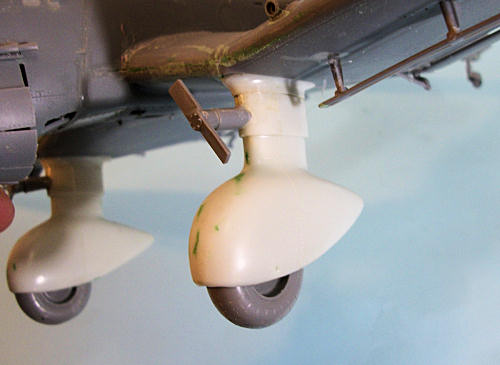 Most importantly, the landing gear spats of the Revell
kit are the right size and shape.
I found that cutting the base of the gear off the wing,
and then reshaping it so it would fit the Trumpeter kit was easy - it took all
of about 10 minutes for each side to accomplish this.
The spats attach easily to the Trumpeter kit and greatly
improve the overall look.
Most importantly, the landing gear spats of the Revell
kit are the right size and shape.
I found that cutting the base of the gear off the wing,
and then reshaping it so it would fit the Trumpeter kit was easy - it took all
of about 10 minutes for each side to accomplish this.
The spats attach easily to the Trumpeter kit and greatly
improve the overall look.
If you don't have the Revell kit, the spats on the 21st
Century Toys kit are accurate in outline, though a bit “clunky” in shape as I
discovered when I contemplated robbing them from my kit for this project.
These could be used to correct this kit, but they're
require some work to “de-clunk” their shape.
I cut off the mounting for the sirens from the Trumpeter
parts and glued them to the Revell gear.
I had the siren props from the Hasegawa Ju-87D-1 kit,
and used those with this model, since I was doing a “classic” Stuka.
Past this, I assembled the kit per the instructions.
I used the Eduard Ju-87B photoetch seatbelts, which
improve the look of the cockpit.
Unless you are going to cut open the cowling, the
complete engine that is supplied isn't going to be seen.
However, it's good to assemble it and install it, since
the lower parts can be seen through the open rear of the radiator housing.
You don't need to worry about painting anything but the
lower parts black.
Comparing the completed wing with a Hasegawa Stuka
model, the separated flaps and ailerons are a bit too close to the
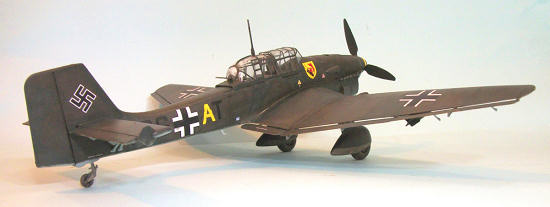 main wing.
One could glue some Evergreen sheet onto the hinges used
to attach these parts to the wing to increase the separation.
I chose to just leave them alone.
main wing.
One could glue some Evergreen sheet onto the hinges used
to attach these parts to the wing to increase the separation.
I chose to just leave them alone.
The canopies are actually incorrect, since the Ju-87 had
most of its bracing internally, something I didn't know until Hasegawa released
their 1/32 Stuka kits.
However, I can live with the external bracing we are all
used to with Stuka kits.
The canopies are superior to Hasegawa's since the
pilot's sliding canopy can be posed open or closed, as can the gunner's canopy.
I used Hasegawa main wheels that I had not used on an
earlier kit so that I didn't have to use the Trumpeter rubber wheels.
The tailwheel came from the Revell kit.
I decided to do a “classic” Ju-87B from the Blitzkrieg,
so did the model in 70/71/65, using Tamiya paints.
I used the sheet from the 21st
Century Toys kit to do an airplane from 6./II/StG51 from the 1940 campaign.
They went on without problem with Microsol.
I left the airplane clean other than to apply exhaust
and oil stains.
I attached the Revell bomb crutch and bomb.
I didn't like the Revell 100kg bombs, and used the
Trumpeter bombs; however, Trumpeter only supplies two bombs rather than four.
I am going to replace these with the Revell bombs before
this model goes out to display at Planes of Fame.
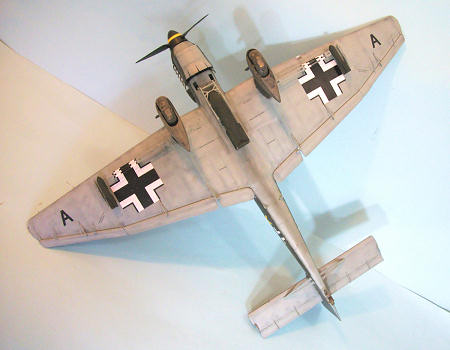 This kit by Trumpeter is the best Ju-87B available in
1/32 scale.
If you can live with the incorrect gear spats, there is not any
problem in assembly.
Since Hasegawa has made no move to scale up their Ju-87B
kit the way they did their Ju-87D and ju-87G kits, this is likely to be the one
kit of this famous airplane available in 1/32.
It looks good sitting next to its Hasegawa brethren.
Recommended.
This kit by Trumpeter is the best Ju-87B available in
1/32 scale.
If you can live with the incorrect gear spats, there is not any
problem in assembly.
Since Hasegawa has made no move to scale up their Ju-87B
kit the way they did their Ju-87D and ju-87G kits, this is likely to be the one
kit of this famous airplane available in 1/32.
It looks good sitting next to its Hasegawa brethren.
Recommended.
Tom
Cleaver
June 2012
Thanks to Stevens International for the review kit.
If you would like your product reviewed fairly and fairly quickly, please contact the editor or see other details in the
Note to
Contributors.
Back to the Main Page
Back to the Review
Index Page






 main wing.
One could glue some Evergreen sheet onto the hinges used
to attach these parts to the wing to increase the separation.
I chose to just leave them alone.
main wing.
One could glue some Evergreen sheet onto the hinges used
to attach these parts to the wing to increase the separation.
I chose to just leave them alone.